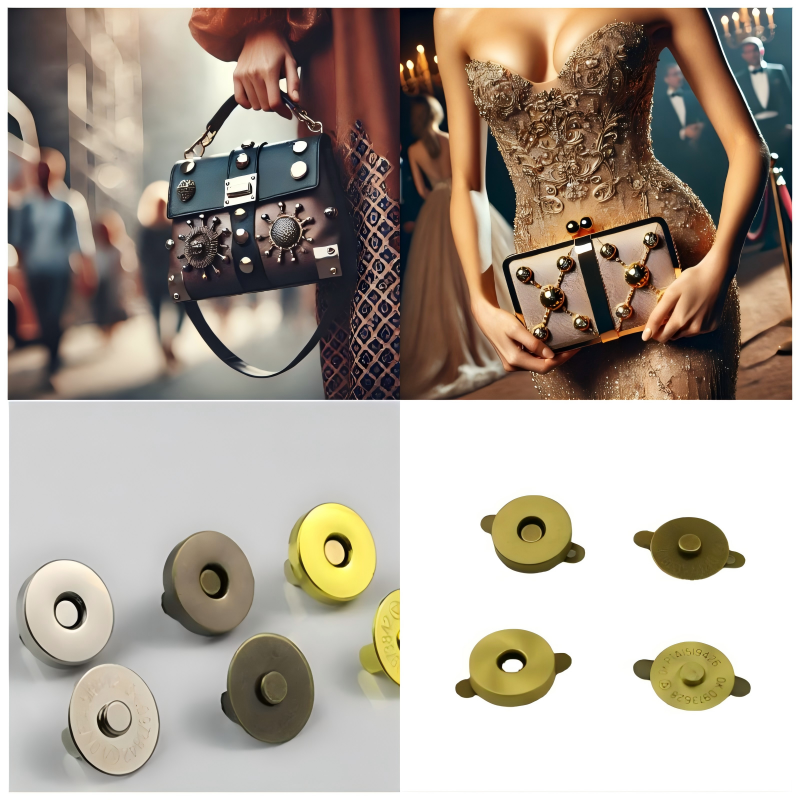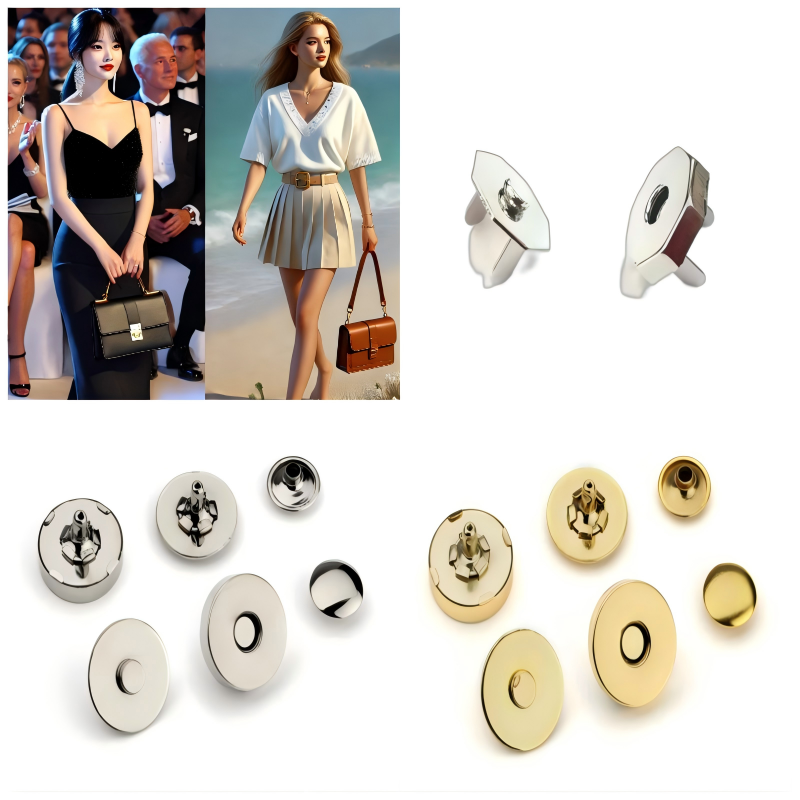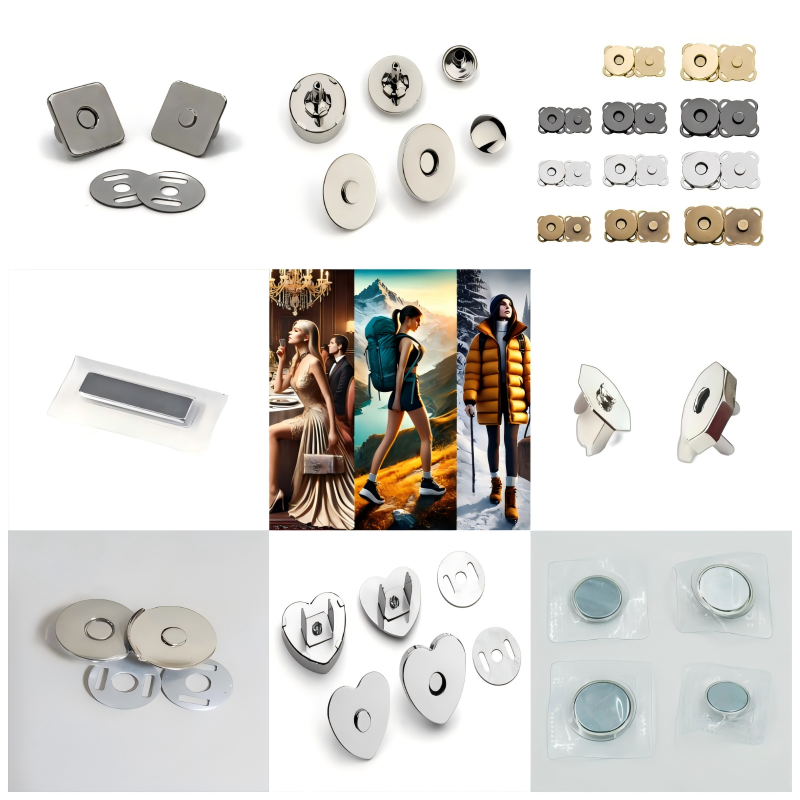Sew On Magnetic Buttons for Clothing Accessories
Sew‑On Magnetic Buttons for Clothing Accessories
In an ever-evolving fashion landscape, where convenience and style must intertwine seamlessly, the humble button has undergone a remarkable transformation. Enter the sew‑on magnetic button—an innovation that merges traditional tailoring techniques with cutting‑edge magnetic closure technology. Designed to elevate garments, handbags, and accessories, these buttons deliver reliable fastening, user-friendly operation, and unparalleled versatility, all while preserving the aesthetic integrity of your creations.





Introduction: The Fusion of Craftsmanship and Technology
For centuries, buttons have functioned as both practical fasteners and decorative accents on clothing. Whether adorning a tailored coat, a flowing blouse, or a structured handbag, buttons convey style, quality, and attention to detail. Yet conventional buttons—be they plastic, metal, or shell—carry limitations: cumbersome snaps, time‑consuming hook‑and‑eye closures, and the risk of fabric stress at perforation points.
Sew‑on magnetic buttons address these shortcomings by integrating a discreet yet powerful magnet assembly into a traditional sew‑on housing. The result is a closure mechanism that:
Engages instantly and securely through fabric layers
Requires minimal manual dexterity
Eliminates bulky snaps or clumsy hook attachments
Preserves garment drape and silhouette
2. How Sew‑On Magnetic Buttons Work
At the heart of every sew‑on magnetic button lies a pair of complementary magnetic discs, each encased in a low‑profile housing. One disc carries a north pole orientation; its counterpart carries the south pole. When brought into proximity, the magnets attract, snapping together with satisfying precision and holding firmly against unintentional separation.
Upper Housing: Sewn onto the garment or accessory’s exterior. It typically features two or more sewing holes to ensure stable attachment.
Lower Housing: Sewn onto the underside or interior of the panel, directly opposing the upper housing.
Magnetic Discs: High‑grade ferrite or rare‑earth materials ensure consistent pull strength, corrosion resistance, and long‑term durability.
By simply pressing the two housings together, the magnetic force locks them into place. To release, a gentle lateral or peeling motion overcomes the magnetic attraction, separating the halves without snagging fabric or requiring brute force.
3. Key Advantages
a) Effortless Operation
Unlike traditional snaps or zippers, which demand precise alignment and forceful levering, sew‑on magnetic buttons offer a “click‑and‑go” experience. This is particularly beneficial for:
Children and elderly users who may struggle with small fasteners
Designers of adaptive or inclusive fashion lines
Busy professionals seeking quick garment changes
b) Gentle on Fabrics
Because magnets hold through attraction rather than mechanical interlock, there’s no strain on buttonholes, no fabric attrition from repeated use, and no risk of teeth catching loose threads. This extends the lifespan of delicate materials such as silk, chiffon, and knitwear.
c) Sleek, Low Profile
Sew‑on magnetic buttons lie flat against the fabric, avoiding the bulk of traditional snaps or buckles. Their minimal thickness ensures that garments maintain clean lines and smooth drape.
d) Customizable Strength
Magnetic pull force can be specified to suit various applications:
Light‑duty (100–200 g pull): Ideal for scarf closures, pocket flaps, and decorative elements.
Medium‑duty (200–500 g pull): Suited to blouses, jackets, and lightweight handbags.
Heavy‑duty (500–1,000+ g pull): Perfect for coats, leather jackets, and sturdy tote closures.
e) Corrosion and Wear Resistance
Premium materials—such as nickel‑plated steel housings and ferrite magnets—offer excellent resistance to moisture, perspiration, and everyday abrasion. This makes sew‑on magnetic buttons an excellent choice for outerwear, sportswear, and travel accessories.
4. Design and Aesthetic Flexibility
Sew‑on magnetic buttons are not merely functional; they’re also a canvas for creative expression. Available in a broad spectrum of finishes—antique brass, polished gunmetal, satin nickel, and more—they can:
Complement existing hardware on garments and bags
Be engraved with logos or monograms for brand identity
Serve as focal design elements in couture and ready‑to‑wear collections
Designers can choose housings that match or contrast with their fabric, from discreetly invisible closures to striking metallic accents that catch the light.
5. Applications Across the Fashion Spectrum
Apparel: Blazers, coats, cardigans, dresses, and childrenswear benefit from magnetic closures that simplify wearability without compromising style.
Handbags & Clutches: Replace cumbersome clasps with sewn‑in magnets for effortless one‑hand operation.
Footwear: As closures on ankle straps or decorative crossings, magnetic buttons provide secure fastening and easy on/off access.
Accessories: Belts, hats, and wrist cuffs incorporate magnets to maintain sleek profiles and user convenience.
Home Textiles: Cushion covers, throw blankets, and slipcovers use magnetic buttons for invisible yet reliable closure.
6. Integration into Manufacturing Processes
Sew‑on magnetic buttons are engineered for seamless integration into both hand‑sewn and automated production lines:
Positioning: Mark the upper and lower housing locations on fabric panels.
Basting: Temporarily tack magnets in place to verify alignment.
Sew‑On: Using industrial sewing machines or manual stitching, secure housings through designated holes with polyester or nylon thread. Reinforce key stress points with bar tacks if desired.
Quality Control: Test magnetic pull strength, alignment, and engagement/disengagement cycles to ensure consistency.
Their uniform dimensions and standardized mounting holes allow production teams to maintain tight tolerances, ensuring reliability across hundreds of garments or articles per batch.
7. Sustainability and Lifecycle Considerations
Increasingly, consumers demand not only style and functionality but also ethical and environmental responsibility. Sew‑on magnetic buttons align with these values:
Longevity: By preserving fabric integrity and eliminating mechanical wear, garments last longer, reducing waste.
Recyclability: Magnet housings—typically steel or aluminum alloys—are recyclable where supported infrastructure exists.
Reduced Hardware: One magnetic button can replace multiple snaps or hooks, decreasing overall material usage.
Forward‑thinking brands can highlight these eco‑friendly credentials as part of their transparent supply‑chain narratives.
8. Choosing the Right Sew‑On Magnetic Button
| Factor | Considerations |
|---|---|
| Pull Strength | 100–200 g for scarves and decorative closures; 200–500 g for jackets and medium‑weight accessories; 500–1,000+ g for heavy coats and leather goods. |
| Housing Finish | Satin nickel for modern minimalism; antique brass for vintage appeal; matte black for stealthy elegance. |
| Thread & Stitching | Use bonded polyester thread for moisture resistance; employ reinforced stitching (bar tack) on high‑stress points. |
| Alignment | Ensure housings are directly opposite one another with no fabric layers misaligned to maintain maximum magnetic pull. |
| Testing | Verify over 500 engagement/disengagement cycles to confirm durability before bulk production. |
| Packaging | Store magnets in anti‑static, anti‑corrosion pouches; label batches with pull‑force rating, size, and finish. |
9. Case Study: Transforming a Heritage Outerwear Line
A venerable outerwear brand sought to modernize its classic trench coat design without sacrificing its artisanal heritage. By replacing traditional horn buttons and cumbersome buckles with matte‑black sew‑on magnetic buttons (500 g pull), they achieved:
Streamlined Silhouette: Eliminated button plackets and reduced bulk at the front closure.
Enhanced Functionality: Customers could close or open the coat in a single hand, even while carrying luggage.
Brand Differentiation: The subtle magnetic “snap” became a hallmark of the updated collection, earning praise from fashion editors.
Sales increased by 15% in the first season, and customer feedback highlighted the blend of convenience and refined aesthetics.
10. Conclusion: The Future of Fastening
As fashion converges with technology, every detail matters—from the curve of a lapel to the smoothness of a closure mechanism. Sew‑on magnetic buttons exemplify this marriage of form and function. They honor the legacy of tailoring while embracing modern user expectations: effortless operation, minimalist design, and durable performance.
Whether you’re a bespoke tailor, an independent accessory designer, or a major fashion house, integrating sew‑on magnetic buttons into your product line can:
Streamline assembly processes
Enhance wearer satisfaction
Differentiate your brand through innovative detailing
Invest in the next generation of garment hardware. Let sew‑on magnetic buttons be the silent hero of your creations—small in profile, monumental in impact.



